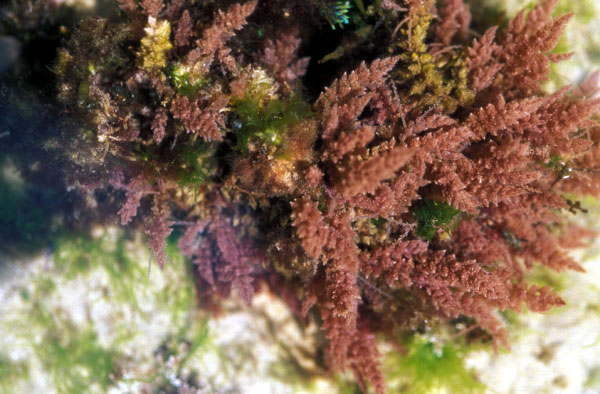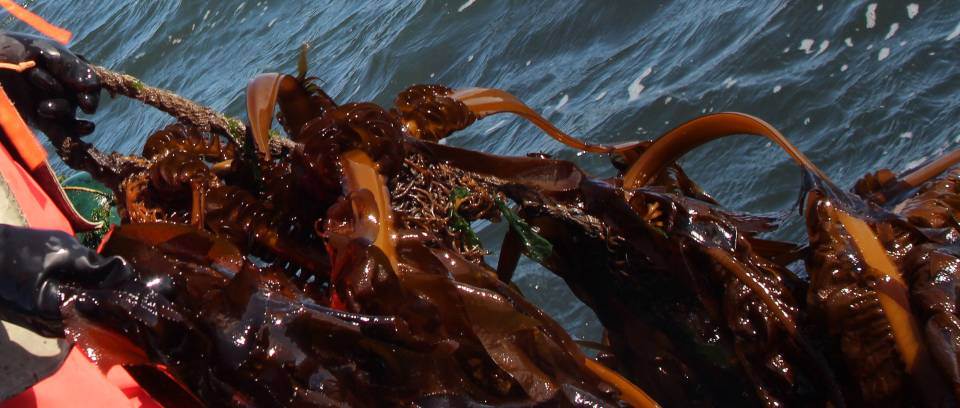In theory Seaweed biomass production is severely hampered by a 10,000 fold slower diffusion rate of a Carbon source or Dissolved Inorganic Carbon (DIC) in the biophysical medium water in comparison to terrestrial C3 crops. Despite this inflicting property pelagic seaweeds outcompetes C3 crops for annual green biomass production which is called “the seaweed-paradox”. Here we have reported our findings and hypothesized that for four seaweed species that due to an internal acidification the abundant oceanic bicarbonate ion (HCO3–) is introduced into the cell which will in the inner acidic mitochondrial environment (matrix) rapidly be converted to CO2 which is the only C-form photosynthetic enzyme ribulose-1,5-bisphosphate carboxylase/oxygenase (Rubisco) can react with to produce with solar energy and water green biomass. We hypothesize this intracellular acidification is performed by reversal of the fifth pump of the chemi-osmotic model of Mitchell. It can be expected that in nearby future seaweeds may play a prominent role in providing the unfettered growth of the world population -estimated at around 10 billion people at the midst of the 21st century: food, fuel and other bioactive ingredients.
Digital library
-
-
The readers chose between transformative bioenergy technologies at more than 250 companies, universities and national laboratories, including 100 organizations that received write-in votes.
-
Introduction: Phlorotannins, the phenolic compounds found in brown seaweeds, are a unique and diverse class of compounds showing a huge potential for food and pharmaceutical applications.
Objective: This review will give an account of the colorimetric assays used and a discussion of their quantitative and qualitative analytical shortcomings. It will also discuss other more complex and modern analytical chemistry methods that are currently being developed to study phlorotannins. The purpose of this review is to increase awareness of these bioactive compounds and promote further development of robust analytical methods for use in biology, food science, pharmacology and biomedical and cosmeceutical sciences.
Results: Whilst the biological activity and huge commercial potential of the phlorotannins has been widely reported throughout the literature, the chemical structures and reactivity of these compounds is still not well understood. The phlorotannin content of seaweed is usually characterised using colorimetric assays. However, although these methods give a reasonable overall estimation of the total phenolic content, they lack precision and specificity.
Conclusion: This review highlights the strengths and weaknesses of commonly used colorimetric assays. Novel techniques are highlighted using more selective chemistry to identify this class of compounds.
-
Oxidative stress induces various cardiovascular, neurodegenerative, and cancer diseases, caused by excess reactive oxygen species (ROS). It is attributed to the lack of sufficient antioxidant defense capacity to eliminate unnecessary ROS. Seaweeds are largely cultivated for their edible and commercial purposes. Excessive proliferation of some seaweeds has occurred in coastal areas, causing environmental and economic disasters, and even threating human health. Removing and disposing of the excess seaweeds are costly and labor-intensive with few rewards. Therefore, improving the value of seaweeds utilizes this resource, but also deals with the accumulated biomass in the environment. Seaweed has been demonstrated to be a great source of polysaccharides antioxidants, which are effective in enhancing the antioxidant system in humans and animals. They have been reported to be a healthful method to prevent and/or reduce oxidative damage. Current studies indicate that they have a good potential for treating various diseases. Polysaccharides, the main components in seaweeds, are commonly used as industrial feedstock. They are readily extracted by aqueous and acetone solutions. This study attempts to review the current researches related to seaweed polysaccharides as an antioxidant. We discuss the main categories, their antioxidant abilities, their determinants, and their possible molecular mechanisms of action. This review proposes possible high-value ways to utilize seaweed resources.
-
The name agar originated from the Malay word “Agar-agar”, the local name in the Dutch East Indies for Eucheuma muricatum (spinosum) (Tseng, 1944) which was exported to China for more than a century. For the sake of simplicity agar-agar was shortened to just agar and is now accepted universally whether in the food and other industries or as culture media. The introduction of agar in bacteriology was achieved by a German housewife, Frau Hesse, who prepared the bouillon from agar-agar for her husband's bacterial cultures. The agar-agar came from Frau Hesse's mother who lived in America which was given to her by some friends who lived in Java. Dr. Walther Hesse was so excited about the efficiency of the new medium which his wife prepared, so he relayed his findings immediately to Dr. Robert Koch who was working at the time on the tubercle bacilli. In 1882, Koch reported on the tubercle bacilli and mentioned the new culture medium (Hitchens and Leikind, 1939). Hitchens and Leikind even suggested agar should be called Frau Hesse's medium in honor of the woman who discovered it. According to Tseng (1944) the agar-agar of Frau Hesse from Java could have been carrageenan from Eucheuma.
Tseng (1944) defines agar as the dried amorphous, gelatin-like, non-nitrogenous extract from Gelidium and other red algae, a linear galactan sulfate, insoluble in cold but soluble in hot water, a 1 to 2 percent solution of which upon cooking solidifies to a firm gel at 35° to 50° and melting at 90° to 100°.
The USP XVIII defines and describes agar as the dried hydrophilic colloidal substance extracted from Gelidium cartilagenium (Linne) Gaillon (Fam. Gelidiaceae), Gracilaria confervoides (Linne) Greville (Fam. Sphaerococcaceae) and related red algae. Unground agar usually occurs in bundles consisting of thin, membranous, agglutinated strips or in cut, flaked or granulated forms. It may be weak yellowish orange, yellowish gray to pale yellow, or colorless. It is tough when damp, brittle when dry. It is colorless or has a slight odor and has a mucilaginous taste. Powdered agar is a white to a yellowish-white or pale yellow, insoluble in cold water, but soluble in boiling water. When boiled with 65 times its weight of water for 10 minutes, with constant stirring, and adjusted to a concentration of 1.5 percent, by weight, with hot water, agar forms a clear liquid which congeals at 32° to 39° to form a firm resilient gel, which does not melt below 85°. Armisen and Galatas (1987) reported a wider range of 34° to 43° for the gelling temperarature. Actually according to our observation, the gelling temperature as well as the melting temperature of a 1,5 percent concentration of agar vary according to the seaweed source, the method of preparation and the purity of the sample. The gelling temperature of the agar sols ranges from 30° to 50° and the melting temperature from 82° to 92°.
-
According to the Sea Change Strategy (2006), the Irish seaweed production and processing sector will be worth €30 million per annum by 2020. If this target is to be reached, then the sector must capitalise on the existing wild resource and it must necessarily expand seaweed aquaculture to augment supplies of higher value seaweeds and to provide product into the abalone and urchin farming sector, which has an estimated need of 2,000 tonnes of wet product per annum, at full production capacity. Seaweed aquaculture in Ireland is limited to only a small number of licensed sites at the current time. According to the most recent data (1997) supplied by the Department of Communications, Marine and Natural Resources (DCMNR) and the Department of Agriculture Fisheries and Food (DAFF) to BIM, there is one algal aquaculture licence in Waterford, two in Cork and one in Galway. That said, at least three further licences have now been applied for, and one has been approved in Kerry. It is hoped that work undertaken during the course of this research project, PBA/SW/07/001(01), ‘Development and demonstration of viable hatchery and ongrowing methodologies for seaweed species with identified commercial value’, will facilitate the licensing and further development of seaweed culture in Ireland. By perfecting culture techniques and making information available to stakeholders, it is anticipated that further engagement can be facilitated to move the seaweed aquaculture sector forward in Ireland.
Ireland’s seaweed and biotechnology sector is currently worth €18 million per annum (Morrissey et al., 2011), it processes 36,000 tonnes of seaweed (wild product) and employs 185 full time equivalents (Morrissey et al., 2011). The product source is currently limited to the wild resource and product range is limited in the main to high volume, low value products such as animal feeds, plant supplements, specialist fertilisers and agricultural products. A smaller proportion goes into higher value products such as foods, cosmetics and therapies. In order to gain more from this industry, it is proposed that processors move down the value chain in order to achieve higher returns from their product. In order to do this, it is suggested that the industry needs to introduce automation and more sophisticated processing and packaging techniques. Reducing labour costs is considered a key driver of increased competitiveness in the sector. Moving away from the more traditional wild species and applying aquaculture techniques to create sustainable year round supply is also key to industry development.
Laminaria digitata and Palmaria palmata are two seaweed species identified as offering opportunity for cultivation in this project. Laminaria can be grown on long lines at sea, while at the current time, vegetative growth of Palmaria in tanks is the growth method that has shown success. Laminaria digitata can be fed as a macroalgivore diet to farmed abalone and urchins. On the other hand, Palmaria palmata is considered a food delicacy and most of the national production is sold and consumed domestically (16-30 tonnes), however there is increasing demand from Spanish and French markets for the product. National production of Laminaria is likely to be the same or lower than Palmaria. Palmaria can also be fed to abalone. The combined requirement for these two seaweeds from the current macroalgivore sector in Ireland is 1,500-2,000 tonnes of product. While the requirement to feed macroalgivores is significant in its need for volume production of seaweed from farming, the production of significant tonnage should not allow for market distortion in terms of the value added/processed product. Dried and packaged bulk
Palmaria makes of the order of €16-€19/kg while Laminaria typically makes €10-€16/kg for bulk quantities.The value added opportunity for Palmaria is significant and pickers of wild product can augment their supplies by cultivating product. New technologies should be investigated to allow further automation of processes, including washing, drying, milling and packaging. A variety of Agencies now exist where linkages can be established for new product development, in particular, for example, in the increasingly fashionable area of functional foods, for example, the BIM Seafood Development Centre, Clonakilty, The Food Technology Centre, St Angelas College, Sligo and Spice O’ Life Ltd in Dunmanway, Cork.
Ireland is trading on its ‘clean green’ image. Seaweed is used in spas and in cosmetics. New food products can be marketed using the promise of the ‘Ireland Brand’. This brand stands for provenance, truth, good value and quality. Ireland has a great number of good restaurants, farmer’s markets and established export markets for seafood products which can be capitalised on by innovative thinking
-
Aqueous protein extracts from 30 Brazilian marine algae were examined for haemagglutinating activity using native and enzyme-treated rabbit, chicken, sheep and human erythrocytes. Most extracts agglutinated at least one of the blood cells used. Sheep and rabbit erythrocytes were more suitable for detection of the agglutinating activity. The minimum protein concentration necessary to produce positive agglutination was usually lower with enzyme-treated erythrocytes than native ones. The five algal protein extracts showing the greatest haemagglutination titre were tested for sugar-binding specificity. Only the activity present in the green alga Cauler pacupressoides was inhibited by simple sugars and not by the glycoproteins tested. The activity of the other four extracts was inhibited by at least one of the glycoproteins utilised.
-
A Note on the Occurrence of Porphyra Kanyakumarjensis (Bangiales: Rhodophyta) along the Kerala coast
Four species of Porphyra, P. vietnamensis. P. suborbiculata, P. indica and £: kanyakumariensis have been reported definitely from the Indian coast. Porphyra kanyakumariensis is now reported at a number of stations along the Kerala coast. In addition, the protein, lipid and carbohydrate content of the species and hydrological parameters of the ambient waters are also given.
-
Algae have attracted considerable interest globally as a potential feedstock for a biobased economy. The industrial and research communities in the UK have much to offer in this space: UK companies and academics have laid the foundations for several now globally-used algal biotechnology and engineering advances, and as an island nation we have a strong history in macroalgal commercial activities.
This roadmap has been commissioned by the NERC-TSB Algal Bioenergy Special Interest Group, to complement its Strategic Research Agenda of 2012. It focuses on the commercialisation potential of algaerelated products, processes and services for the UK, being mindful of environmental implications. It builds on the outcomes of two workshops held by AB-SIG in October and November 2012 with a variety of stakeholders, whose contributions are gratefully acknowledged.
The report signposts the strengths of the UK science base, gives a snapshot of UK and global algal industries, and presents an overview of trends and opportunities for algae–derived products and services. Based on these, it assesses the UK’s potential for profiting from international markets, and highlights actions required to compete in a global marketplace. It then presents seven sectors which the workshop participants had identified as being of particular relevance and value for the UK. Examples of products or processes in each sector are given in case studies which evaluate their commercial, technical and environmental strengths and weaknesses.
-
-
Comprehensive overview of the state-of-the-art in biofuel technology
-
40 chapters written by almost 100 contributing researchers
-
Topics arranged in 8 sections
-





